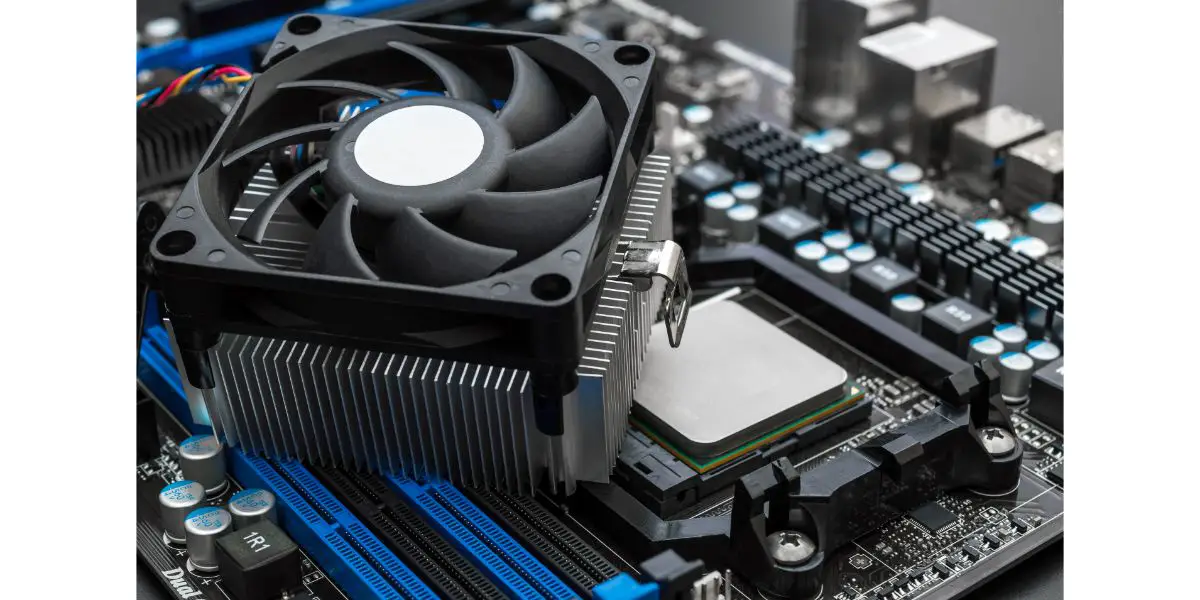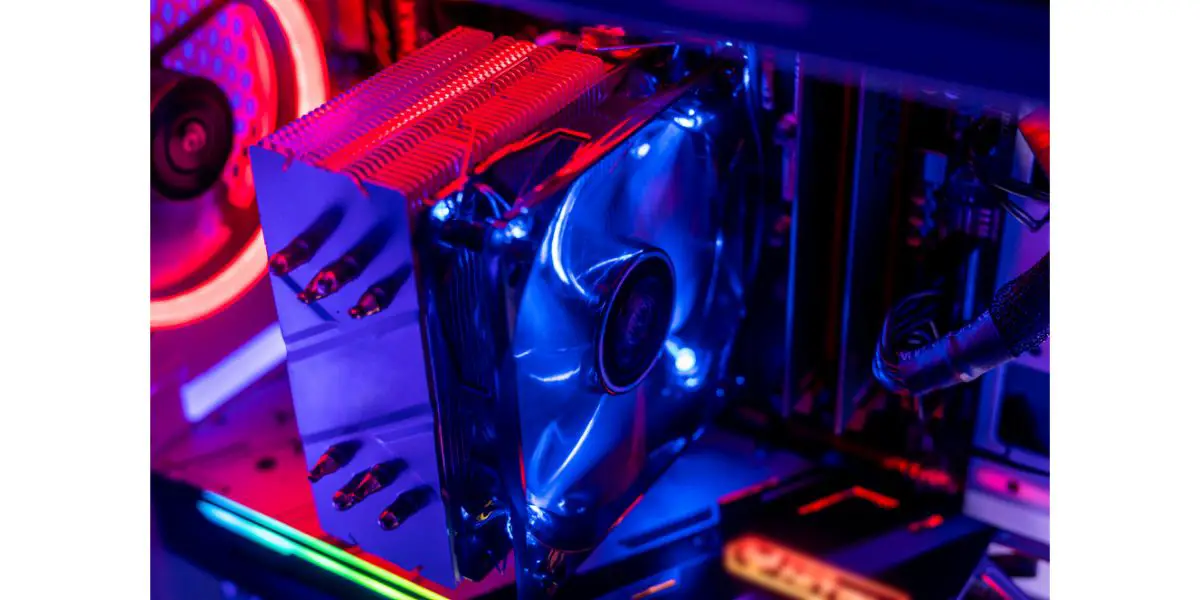Disclaimer: This post may contain affiliate links, meaning we get a small commission if you make a purchase through our links, at no cost to you. For more information, please visit our Disclaimer Page.
A CPU fan should always be on to prevent overheating and potential damage to the processor, according to most recommendations. However, the decision to keep the fan running can depend on factors such as energy efficiency, noise levels, and the specific cooling needs of the computer.
Let’s discuss the function of CPU fans, the potential dangers of not running a CPU fan, and the different options for controlling a CPU fan, so you can understand its functions.
Table of Contents
Does a CPU Fan Always Have To Spin?
You may have rarely considered the value of your CPU fan, but as you push your processor to the limit, it’s your best tool for keeping the processor cool.
The processor, or CPU, is the brain of the computer. It handles most computations and generates a lot of heat in the process. Without proper cooling, that processor can overheat, leading to decreased performance.
An overheated CPU will cause your applications to shut down or slow down as the computer tries to regulate its temperature. Your fan will likely whirr faster and louder as it works harder to bring the internal temperature down. Eventually, the heat can melt and damage parts of your motherboard, resulting in a complete shutdown.
Preventing such overheating and related issues is where the CPU fan comes in.
The CPU fan blows cool air onto the processor to dissipate the heat. The fan works with heatsinks and thermal pastes to perform this task. It can be controlled through the computer’s BIOS or third-party software.
The fan speed can be adjusted to match the cooling needs of the computer, but it’s important to keep the fan running at all times to ensure that the processor stays cool. Without a functioning fan, or if the fan is not running properly, the processor can overheat, leading to potential damage to the hardware and significant performance issues.
Overheating can also cause other components, such as the memory or power supply, to fail and need replacing. It’s crucial for the CPU fan to always be spinning to prevent the costly and damaging effects of overheating and keep your computer running smoothly.
Keeping the fan on at all times can also help to improve energy efficiency and noise level.
This notion that a continuously running fan will improve efficiency and noise may seem somewhat counterintuitive. But by always running at a low speed, the fan avoids long instances of running at high speeds, which can eat up power. This efficiency can even further be achieved by using software that monitors the temperature and adjusts the fan speed accordingly.
Overall, a CPU fan is an essential component that helps to keep the processor cool and prevent overheating.
Checking the function of the CPU fan, and taking steps to fix any issues that may arise, can help ensure your CPU fan’s proper functioning. And with a functional CPU fan, you’ll be able to keep your computer running smoothly.
CPU fans are a sophisticated part of your computer setup and can often be taken for granted. To learn more about CPU fans, check out our breakdown of the most common questions about CPU fans, along with detailed explanations.
How To Maintain and Troubleshoot Your CPU Fan
As discussed, the CPU fan plays a critical role in keeping the processor cool and preventing overheating.
However, maintaining and troubleshooting the CPU fan can be a bit tricky. So, here are some detailed tips and guidance on maintaining and troubleshooting your CPU fan to ensure proper functionality.
Clean Your CPU
Dust and debris can accumulate on the fan blades and the surrounding area, impeding the fan’s ability to dissipate heat.
If you need to clean the fan, use compressed air to blow out dust and debris. Be sure to also clean the surrounding areas, including the heatsink and the vents on the computer case. If your machine is exposed to a lot of dust, this is recommended for regular maintenance.
Watch The Temperature
It’s important to adjust the fan speed and the temperature of the CPU. If the temperature is getting too high, you may need to clean the fan or consider other options to improve your computer’s cooling.
To do this, you can use paid tools like SolarWinds, or an open-source alternative, such as Open Hardware Monitor. Here’s a breakdown of how to check your temperature speed yourself.
Keep An Eye on The Fan Speed
If your fan speed runs too low, the CPU may be at risk of overheating. Check your computer’s BIOS or third-party software to see the speed and ensure it is set to the correct speed.
You may wonder what the ideal speed is for your fan. Here’s a breakdown based on fan size
- 140 mm (5.51 in) fans: 600 – 800 RPM
- 120 mm (4.72 in) fans: 750 – 1000 RPM
- 92 mm (3.62 in) fans: 1000 – 1300 RPM
- 80 mm (3.15 in) fans: 1250 – 1600 RPM
Listen To The Fan Noise
If your fan is making unusual noises, clean it and check for debris. If that doesn’t resolve the noise, it may be time to replace the fan.
If you need to install a new fan, use one designed for your specific computer model. The issue could stem from other hardware problems, like a malfunctioning fan controller or damaged fan bearing, so you may not require a full replacement. Always consult a professional if you’re unsure about what changes are needed.
Keep It Cool
Using and storing your computer in a cool and well-ventilated place can help reduce the fan’s workload. That will, in turn, improve the fan’s performance and lifespan. To ensure this is the case, you may want to consider adding extra fans to desktop computers or using a cooling pad for your laptop.
Run Regular Updates on Your Computer
Ensure that you keep your computer’s BIOS and third-party software updated to their latest versions. Regular software updates will help improve the functionality of the CPU fan and also prevent any software issues that could cause future problems with the fan.
Before performing any hardware maintenance or replacement, I recommend checking your computer’s warranty (if any) and documentation.
For example, if you’re running a Dell, they provide these specific instructions for troubleshooting your fan. Doing maintenance or replacements yourself may void the warranty or cause issues with service.
Following these tips, when necessary, can ensure CPU fan performance and fix any issues that may arise. By keeping your CPU fan in good working order, you can help keep your computer running cool to push your processor to its limits.
Controlling the Noise Level of Your CPU Fan
A CPU fan is highly necessary for your computer, but it can also be a distracting source of noise. Fan noise is often one of users’ biggest complaints about their computers. However, there are some steps you can take to ensure that your fan is still running and keeping your CPU cool but also operating at a volume that doesn’t annoy or distract you from your working or gaming flow.
Before taking steps to reduce the fan’s noise, it’s important to understand the factors affecting the volume.
These factors include the fan’s size and speed, the fan blades’ design, and the materials used to construct the fan. Additionally, the noise level will also vary depending on the fan’s location within the computer case and the ventilation of the case itself.
If any of those situations are causing a CPU fan to produce excess noise, there are several steps to take that will reduce noise levels.
- You get what you pay for. Investing in a high-quality fan designed to operate quietly will help reduce the noise level of your CPU fan. If noise is a concern for you, look for fans that are specifically designed to operate at low noise levels.
- Monitor and optimize. Utilizing software to monitor the temperature and adjust the fan speed accordingly can help reduce the fan’s noise level. This way, you can control the efficiency of your fan and monitor how hot your CPU is running. This kind of monitoring can also help catch potential issues if your CPU is hotter than expected.
- Dampen the volume. Adding insulation to the computer case can help to dampen the noise generated by the fan. Be careful, however, that insulation doesn’t also lead to heat buildup in the computer.
- Ventilate the computer space. Placing the computer in a well-ventilated area can help reduce the fan’s noise level by allowing it to operate more efficiently. Also, look into options for external cooling pads or installing additional high-quality fans to your computer case.
There is no doubt that you need to be running your CPU fan, but by taking these steps, you don’t need to be distracted by its presence.
Final Thoughts
It’s important to keep the CPU fan running at all times to ensure that the processor stays cool and the computer runs smoothly. Proper maintenance, troubleshooting, and management of the noise level of the CPU fan can keep you happy while prolonging its lifespan and improving its performance.


